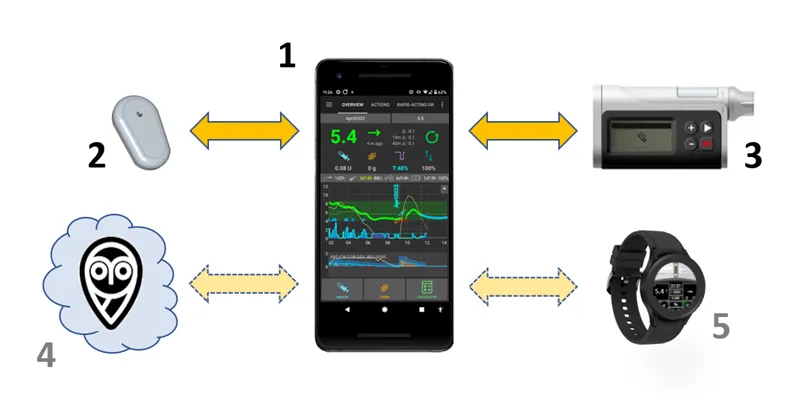When DIY Tech Becomes Life-Changing: A Journey with Diabetes and Open Source
Years of sleepless nights and constant monitoring defined life for friends whose young daughter has Type 1 Diabetes. Using the open‑source Android APS with Nightscout, we transformed her care stabilizing blood sugar, building her independence, and proving how technology can truly change lives.

It’s 2:13 AM, and the alarm goes off again. Another night of waking to check a child’s blood sugar. For parents of children with Type 1 Diabetes, this is not a rare event, it’s every night.
Type 1 Diabetes is a chronic condition where the body’s immune system attacks and destroys the insulin-producing cells in the pancreas. Without insulin, the body cannot regulate blood glucose levels, so people with this condition must constantly monitor their blood sugar and adjust insulin manually or through technology. For young children, this means parents carry the responsibility day and night.
For years, close family friends of ours lived this reality. Every night, multiple times, they would prick their daughter’s finger to test her blood sugar, adjusting insulin as needed. The exhaustion and worry were constant companions.
First Steps Toward Relief
Relief came in the form of the Dexcom continuous glucose monitoring device. Worn on the body, it continuously measured blood sugar levels and sent updates to a mobile device, triggering alarms when glucose was too high or low. This reduced the number of painful finger-pricks, but it didn’t eliminate nightly alarms or the need for manual insulin delivery. The family still had to react, often abruptly, to changing levels.
Then came a turning point. My wife’s friend discovered an open-source, do-it-yourself project called Android APS combined with Nightscout. It promised something transformative, an artificial pancreas system that could automate much of the management process. Although I knew little about diabetes at the time, she asked me for technical guidance, and I agreed.
Testing the DIY Solution
Before introducing it to her daughter, we needed to be sure it worked safely. I volunteered as the first test subject, wearing a Dexcom sensor connected to xDrip, Android APS, and Nightscout.
For someone healthy who normally does not need such a device, wearing it means physically attaching the sensor to the skin with an applicator that pushes a tiny needle just under the surface, allowing it to read blood sugar levels every five minutes.
While I didn’t have an insulin pump, the system simulated dosing through a virtual pump. The results were impressive and, for me as a healthy person, it was fascinating to observe my own glucose levels throughout the day, seeing how a healthy pancreas does its work. Real-time monitoring, predictive adjustments, and built-in safety limits all worked together to minimize extreme highs or lows.
How the System Works

The diagram from the AndroidAPS documentation illustrates the setup and communication flow:
- Android APS Smartphone – Runs the main application and algorithms, displaying real-time glucose levels, trends, and insulin activity.
- Dexcom Sensor – Continuously measures glucose levels and transmits the data to the smartphone via Bluetooth.
- Insulin Pump – Receives dosing instructions from Android APS and delivers insulin accordingly.
- Nightscout – Stores, visualizes, and shares glucose and insulin data for remote monitoring.
- Smartwatch – Displays glucose data and alerts on the wrist for quick access.
Data and Communication Flow: Dexcom Sensor sends data to the smartphone via xDrip, then Android APS performs calculations and sends instructions to the insulin pump. Data is also sent from Android APS to Nightscout for remote monitoring, with optional smartwatch updates. As the most important flow happens on the device, the system works even offline.
Safety and Safeguards: Android APS operates within strict safe ranges to prevent overdosing. Predictive models adjust delivery gradually and anticipate future highs or lows. Manual override is always available.
Remote Commands via SMS: Parents can send secure, pre-authorized SMS commands to the child’s smartphone. These can trigger actions such as delivering a bolus, which is a calculated insulin dose before meals to manage blood sugar spikes. This is especially useful when the child is at school or away from home.
All components, xDrip, Android APS, and Nightscout, are open-source, created by volunteers and non-profits, and available free of charge.
The Courage to Try
Adopting DIY medical technology involves trust and responsibility. In this case, the courage shown was especially profound. After I had tested the system myself, there came the day when I assembled all components and made the switch for real.
From that moment on, the mother connected her own daughter to the system, which, while operating within several strict safety safeguards, was now able to control parts of her daughter’s body. From my perspective, that is tremendous courage to say, “I not only tried it, but I am actually applying it on my daughter’s body.”
The mother weighed the benefits against the risks, such as reliance on university and medical approved plus community-tested algorithms, and decided the potential for a calmer, safer life was worth it. “I see the advantages, the clear benefits, even knowing the risks. It requires work, it requires monitoring, but if we look at the results, it’s worth it,” she told me.
A Life-Changing Impact
The morning after their first full night using Android APS, they called me. For the first time in years, they had slept through the night without an alarm. The system had managed a low overnight reading by adjusting insulin delivery automatically.
Over time, the technology became a teaching tool. The mother explained how food affects glucose, how to anticipate changes, and how to adjust insulin proactively. As the daughter gained confidence, she began managing the system day in and day out. She learned which types of food required specific actions within the system and how to interpret the signals and alerts it produced. This shift not only empowered her but also eased her parents’ constant watchfulness.
The child’s growing independence led directly to a calmer household. Anxiety lessened, sleep improved, and the emotional strain on the family eased dramatically. Technology had moved beyond convenience, it had transformed their quality of life.
What began as a technical favor became a deep friendship with the entire family. The parents’ gratitude for both technical help and emotional support strengthened our bond in ways I hadn’t anticipated.
Respect and an Invitation to Act
This journey left me with deep respect for the open-source community. Volunteers around the world built and maintain these tools, making life-changing technology available to anyone who needs it.
If you are living with Type 1 Diabetes and want to learn more about this system, I invite you to reach out to me. I am happy to share my experience and give more details, in addition to what can be found in the official Android APS documentation.
Look for ways your skills can improve lives. Whether through open-source contributions or local support, you might find, like I did, that your expertise can change not just systems, but lives.
Enjoyed the post or have feedback? I’d love to hear from you — just reply via email, or connect on LinkedIn. Feel free to share this post on X, LinkedIn, or Facebook if you think someone else might enjoy it too.

